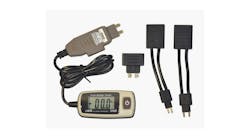In the automotive aftermarket world, there are many types of power tools available to technicians. The most important things to consider when making power tool purchases will vary depending on the specific application the tool is needed for and the types of vehicles your shop services. The following criteria will help you choose which tool to put in your toolbox: torque requirements, available space, tool category (impact wrench, drill driver, impact driver and ratchets) and battery size.
Impact Wrenches
According to Brian Fetner, global product manager for Ingersoll Rand Power Tools, the impact wrench is the No. 1 power tool used in the automotive aftermarket industry. That being said, there are many manufacturers of impact wrenches available to technicians, ranging from low-cost, do-it-yourself (DIY) to expensive, top-of-the line impacts in terms of price and durability.
"I think a lot of time durability gets overlooked. And price can be the offsetting factor," says Fetner, adding, a technician doesn't always want to pay for that durability. "I think they’d want to buy the best tool they can because they use this day in and day out," says Fetner.
When comparing impacts, torque/power is a must, but power-to-size and power-to-weight ratios are also important to keep in mind. As the drive size goes up, and the torque ability goes up, so does the overall tool size and weight.
Impacts are classified by drive size: 1/4", 3/8", 1/2", 3/4" and 1". The 1/4" and 3/8" impact wrenches, because of lower torque ranges and small size, are best suited for light duty vehicles where space is limited. The 1/2", 3/4" and 1" impact wrenches, with high torque settings and increased size and weight, are designed for heavy truck, bus and commercial vehicle applications.
When determining the right impact wrench for you, ask yourself, "Does it give me the performance, size and weight I need?" and "Does it offer durability at the right price?"
Drill Drivers
With a drill driver, you can drill or fasten, depending on the types of bits you use. Fetner describes the drill driver as the "Jack of all trades" tool.
While, not every technician has the need of a drill driver, an auto body technician will find a need for a drill often. Drill drivers come in 1/4", 3/8" and 1/2" chucks. Technicians in the market for a drill driver should ask, "How often do I drill versus drive? If I drive more than I drill, can I get by with another type of tool?"
"If the answer is, 'I drill a lot,' I need to know what I drill and what size of holes I drill," says Fetner. The types of materials technicians drill (steel or aluminum vs. plastic) also plays a part in this decision. This will tell technicians how much power they need out of a tool and which chuck size to purchase. Fetner says for a body technician drilling out spot welds, a 3/8" and 1/2" chuck would be perfect.
Impact Drivers
If torque is not your No. 1 requirement, an impact driver, which offers speed, ease-of-use and versatility, can be an extremely useful tool, says Fetner. Typically, an impact driver offers a cruder mechanism than a drill driver, with more chatter, so drilling isn't really an option. "You could get away with it, but I wouldn't recommend it." Fetner adds, "It is great for fastening."
Because impact drivers offer fast speeds with lower torque, they can be used as tools to finish off a job, without over-torqueing.
Ratchets
Although classified as more than a hand tool, a ratchet doesn't offer the speed or power of an impact. Due to the smaller size of a ratchet, it can fit into confined spaces, but it can also be used to break free a bolt using the technician's "elbow grease." Fetner says, “However, with a ratchet mechanism it can cause reaction, so the result can bust your knuckles. The higher the torque, the higher the reaction."
Torque specifications for a ratchet are much lower compared to an impact wrench. The maximum torque limit is around 100 ft/lbs. After that you won’t be able to hang onto the tool due to the reaction, says Fetner.
Ratchets are available in 1/4", 3/8 and 1/2" drives. "Someone who works in a body shop uses a lot of ratchets. Heavy duty truck and bus, is usually less frequent because the bolts are bigger and require more torque," says Fetner. "The smaller the drive, the smaller the ratchet, the smaller the performance, the smaller the space you can use it in."
Battery Power
The voltage of a battery is the first specification that classifies a power tool within its category. The battery dictates run-time and size. "The more powerful the tool, the more energy it needs, the more Li-ion cells you need to power the tool and so on." Fetner says, "Find the happy medium between battery size for performance of the tool and run-time because batteries can get heavy."
According to Fetner, batteries are probably the No. 1 detractor of a cordless tool, so technicians should look for a tool that offers the amount of power they need, while remaining light enough to use.
Because the batteries are the lifeline of a cordless tool, he adds, "To have more tools than batteries is probably the biggest mistake (a technician) could make." He suggests one battery per tool and an additional battery on-hand, and consider batteries that can be used for multiple tools, which may provide you an overall cost savings.

